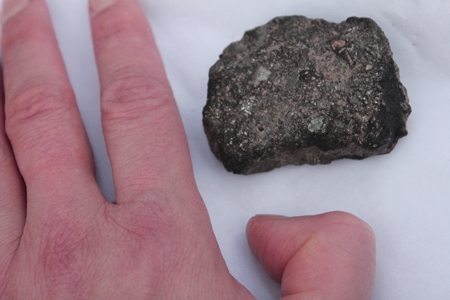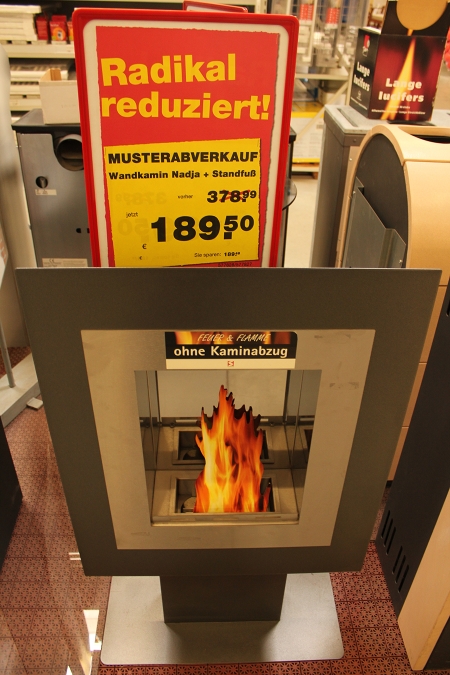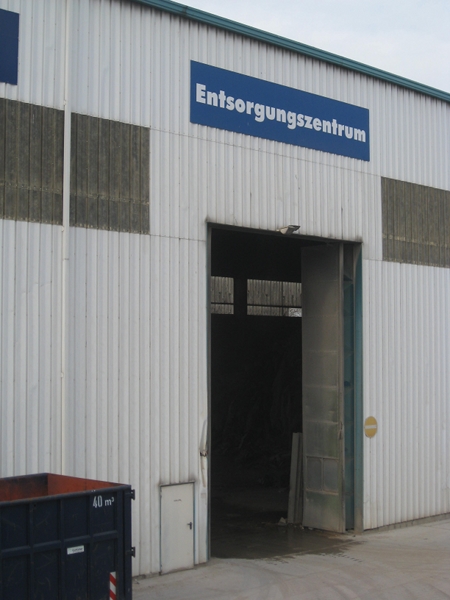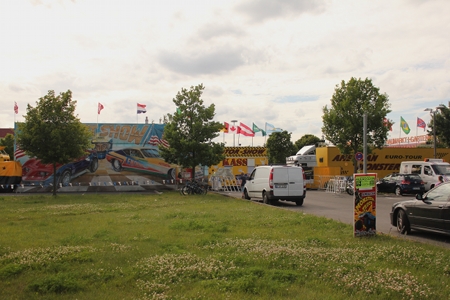
“Meeresfürchte”, an artwork by Johann Merkewicz questioning food safety
I am currently have an argument with John Baez on Azimuth. My comment is currently awaiting moderation.
John wrote:
..the death toll due to nuclear power was a negligible fraction of the overall death toll due to the tsunami. The Japanese should be improving nuclear safety and building in better organizational checks and balances, rather than shunning nuclear power.
What do you call negligible?
According to Wikipedia there were 15883 confirmed earthquake/Tsunami related deaths and 2,676 people missing.
In an Bloomberg article by R.P. Gale and E. Lax one finds:
And what of the lasting threat from radiation? Remarkably, outside the immediate area of Fukushima, this is hardly a problem at all. Although the crippled nuclear reactors themselves still pose a danger, no one, including personnel who worked in the buildings, died from radiation exposure. Most experts agree that future health risks from the released radiation, notably radioactive iodine-131 and cesiums-134 and – 137, are extremely small and likely to be undetectable.
Even considering the upper boundary of estimated effects, there is unlikely to be any detectable increase in cancers in Japan, Asia or the world except close to the facility, according to a World Health Organization report.
On the website of the World Health Organization report one finds amongst others:
In terms of specific cancers, for people in the most contaminated location, the estimated increased risks over what would normally be expected are:
all solid cancers – around 4% in females exposed as infants;
breast cancer – around 6% in females exposed as infants;
leukaemia – around 7% in males exposed as infants;
thyroid cancer – up to 70% in females exposed as infants (the normally expected risk of thyroid cancer in females over lifetime is 0.75% and the additional lifetime risk assessed for females exposed as infants in the most affected location is 0.50%).
By this it looks indeed as if one wouldn’t see an increase of the overall cancer rate in all over Japan. However it is not said here what this means in absolute numbers. How many more cancer cases/deaths are there to be in total?
(This report is also cited by the german GRS report as “the” main source (see p.59) for the estimation of future health risks due to the Fukushima accident.)
In the above citation of R.P. Gale and E. Lax it is in addition mentioned that there were no deaths due to radiation exposure. World-nuclear.org (which I often cite, because they are rather pro-nuclear and often rather well-informed) seems to assert the same, they write:
There have been no deaths or cases of radiation sickness from the nuclear accident, but over 100,000 people had to be evacuated from their homes to ensure this. Government nervousness delays their return.
(please note that from this sentence it can be (and usually probably will be) ambiguously infered that “There have been no deaths from the nuclear accident…”, which is not true, please read further)
The assertion that there had been no deaths due to radiation (which is also cited as such on Wikipedia) is eventually based on a sofar unpublished study by UNSCEAR , which was mentioned in an article by Brumfield, who writes:
So far, neither operator seems to have suffered ill effects as a result of their exposure.
Furthermore it seems that the UN thinks there were 6 dead workers, who did not die from radiation.
I think this should be scutinized. In an email from Karl Feintuch at the United States Nuclear Regulatory Commision (USNRC) (p. 76) (here another internet capture) it is reported that:
Japan reports 5 persons have received lethal radiation doses
but as he points out: there should be “caution regarding maturity and reliability of that information”. Furthermore Tepco reported at least one death, which sounds to me by the description very much radiation related (but this is only a Google translate):
For one person seriously injured who had been trapped in the tower crane cockpit of the exhaust tube,
Is transported to the ground from the tower crane in 13 minutes 5:00 pm today, died in 17 minutes 5:00 pm
Has been confirmed.
Moreover if you read reports as the article “Worker wants new government to secure safety at Fukushima plant” in Asahi Shimbun, than you may ask yourself how exhaustive and good is the monitoring of the health of workers at the Fukushima plant?
A TEPCO employee in his 20s who grew up in Fukushima Prefecture has become an opponent of nuclear power after the accident at the Fukushima No. 1 plant.
“I was told to work at the plant like a kamikaze pilot,” said the man, who is evacuating from Fukushima Prefecture due to high levels of radiation he received. “I have no idea about how much radiation I was exposed to.”
What kind of treatment receive these workers who risk their health and lives for mitigating the effects of such a catastrophe?
But let’s have again a look on the overall mostly future expected casualities:
According to the study “Worldwide health effects of the Fukushima Daiichi nuclear accident” by John E. Ten Hoeve and Mark Z. Jacobson (via Bloomberg.com)
We find that inhalation exposure, external exposure, and ingestion exposure of the public to radioactivity
may result in 15 to 1300 cancer mortalities and 24 to 2500 cancer morbidities worldwide, mostly in Japan. Exposure of workers to
radioactivity at the plant is projected to result in another 2 to 12 cancers cases.
So their “best estimate” as Evan Douple called it in the bloomberg article is about 130 deaths.
The Results were evaluated against daily worldwide Comprehensive Nuclear-Test-Ban Treaty Organization (CTBTO) airborne radionuclide concentrations and deposition rates from around Japan.
Atmospheric and ground concentrations of iodine-131 (I-131), cesium-137 (Cs-137) and cesium-134 (Cs-134) were then used to estimate the worldwide health effects from the radioactive fallout
On a first glance into the paper it looks to me as if for example sea and groundwater contamination via the ongoing release of contaminated water and eventual future contaminations had not been taken into account.
The study
Accounting for long-term doses in “worldwide health effects of the Fukushima Daiichi nuclear accident” Jan Beyea, Edwin Lyman and Frank N. von Hippel (via asianscientist.com) finds:
On balance, the net result of adjusting the TH&J numbers to account for long-term dose from radiocesium is uncertain, but the mid-range estimate for the number of future mortalities is probably closer to 1000 than to 125.
According to a report in Yomiuri Shimbun there are at least 537 deaths which had been certified by municipalities as a direct consequence of the Fukushima disaster.
So if one accepts a cancer related death toll of 1000 people (i.e. a higher but possible projection in the Ten Hoeve and Jacobson fallout study or the expected average toll in the Beyea, Lyman and von Hippel article) and if adds these the stress related 573 deaths one has currently a prognostized Fukushima accident death toll of about 1600 people.
This is roughly about one tenth of the casualties of the earth quake/Tsunami catastrophe. Is that negligible?!
Moreover the Fukushima air circulation blew about roughly 81% of the fallout onto the open sea. That means if the winds would have been blown onto land then this would have given at least a factor 5 more fallout on possibly populated land (if one assumes approximately equal population density). But if one takes into account that the wind almost never blew into south direction (eventual erranous personal observation) , i.e. almost never into the direction of the densely populated Tokyo area then it sounds cautious to assume a factor of ten for what the cancer rates could have been under different weather conditions. That is in that case the death toll could have been about as big as the death toll of the earth quake/Tsunami catastrophe.
And I don’t want to imagine the death toll which would have been a reality if additionally a criticality event would have turned into a chain reaction.







